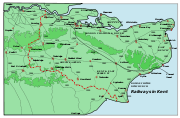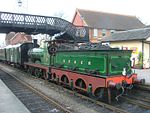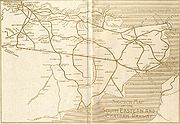
South Eastern and Chatham Railway
Encyclopedia

South Eastern Railway (UK)
The South Eastern Railway was a railway company in south-eastern England from 1836 until 1922. The company was formed to construct a route from London to Dover. Branch lines were later opened to Tunbridge Wells, Hastings, Canterbury and other places in Kent...
(SER) and London, Chatham and Dover Railway
London, Chatham and Dover Railway
The London, Chatham and Dover Railway was a railway company in south-eastern England from 1859 until the 1923 grouping which united it with other companies to form the Southern Railway. Its lines ran through London and northern and eastern Kent to form a significant part of the Greater London...
(LC&DR), that operated services between London and Southeast England. Between 1899 and 1923 the SE&CR had an effective monopoly of the railway service in Kent, and several of the main Channel ports for ferries to France and Belgium.
The companies had competed extensively over the same area, with some of the bitterest conflicts ever seen between British railway companies. Competing routes to the same destination were built; thus many towns in Kent were served by both companies, and left with a legacy of two stations and services to multiple London termini.

Formation
By the end of the 19th century the SER and LC&DR had fought over a small and not particularly lucrative territory for 40 years. Both were notorious for the poor quality of their services and decrepitude of their stock, and the struggles had driven both companies to the verge of bankruptcy. It became inevitable that they must combine or succumb.The SE&CR was formed on 1 January 1899, when the SER and LC&DR formed a "managing committee" comprising the directors of both companies. This effectively merged the two companies, although officially they remained separate, with the receipts split 59% to SER and 41% LC&DR, until the Grouping; this was to avoid the financial costs and risks of a formal merger.
Integration

Further development

- Tattenham Corner LineTattenham Corner LineThe Tattenham Corner Line is a railway line in Southern England. It was opened in two parts: from Purley to Tadworth as the Chipstead Valley Railway in 1893, and to Tattenham Corner as the Epsom Downs Extension Railway in 1894. Both companies were then acquired by the South Eastern Railway...
- KingswoodKingswood railway stationKingswood railway station is in the county of Surrey. It is a late-Victorian station on the Tattenham Corner Line. Train services and the station are operated by Southern....
to Tattenham CornerTattenham Corner railway stationTattenham Corner railway station is in Surrey, in England. The station and all trains serving it are operated by Southern, and it is the terminus of the Tattenham Corner Line. London-bound trains head south as far as Tadworth, then turn east and finally north....
, in 1901. - The Sheppey Light RailwaySheppey Light RailwayThe Sheppey Light Railway was a railway on the Isle of Sheppey, Kent, England which ran from Leysdown to Queenborough, where it connected with the South Eastern and Chatham Railway's Sheerness Line. It was engineered by Holman Fred Stephens and opened in 1901 and closed on December 4, 1950...
- branch off the Sheerness LineSheerness LineThe Sheerness Line connects Sheerness on the Isle of Sheppey in Kent with Sittingbourne on the mainland, and with the Chatham Main Line for trains to London and elsewhere in Kent. It opened on 19 July 1860....
, in 1901 (closed 1950). - Bexhill branch off the Hastings LineHastings LineThe Hastings Line is a railway line in Kent and East Sussex linking Hastings with the main town of Tunbridge Wells, and from there into London via Sevenoaks.-Openings:The line was opened by the South Eastern Railway in main three stages: – :...
- CrowhurstCrowhurst railway stationCrowhurst railway station is on the main London - Tunbridge Wells - Hastings line in East Sussex in England, and serves Crowhurst. Train services are provided by Southeastern.- History :...
and Bexhill West, in 1902 (now closed).
SE&CR locomotives
The LC&DR's works at LonghedgeLonghedge Railway Works (Battersea)
Longhedge railway works was a locomotive and carriage works built by the London, Chatham and Dover Railway in the borough of Battersea, South London to serve their new London terminus at Victoria...
, Battersea
Battersea
Battersea is an area of the London Borough of Wandsworth, England. It is an inner-city district of South London, situated on the south side of the River Thames, 2.9 miles south-west of Charing Cross. Battersea spans from Fairfield in the west to Queenstown in the east...
was closed in 1911 and production was concentrated at Ashford
Ashford railway works
Ashford railway works was in the town of Ashford in the county of Kent in England.-South Eastern Railway:Ashford locomotive works was built by the South Eastern Railway on a new site in 1847, replacing an earlier locomotive repair facility at New Cross in London...
. Harry Wainwright
Harry Wainwright
Harry Smith Wainwright was the Locomotive, Carriage and Wagon Superintendent of the South Eastern and Chatham Railway from 1899 to 1913. He is best known for a series of simple but competent locomotives produced under his direction at the company's Ashford railway works in the early years of the...
was replaced by Richard Maunsell
Richard Maunsell
Richard Edward Lloyd Maunsell held the post of Chief Mechanical Engineer of the South Eastern and Chatham Railway from 1913 until the 1923 Grouping and then the post of CME of the Southern Railway in England until 1937....
as Locomotive Superintendent in 1913.
- List of locomotives
Electrification
Prior to grouping, with the development and implementation by competitors (notably L&SWRLondon and South Western Railway
The London and South Western Railway was a railway company in England from 1838 to 1922. Its network extended from London to Plymouth via Salisbury and Exeter, with branches to Ilfracombe and Padstow and via Southampton to Bournemouth and Weymouth. It also had many routes connecting towns in...
, LB&SCR
London, Brighton and South Coast Railway
The London, Brighton and South Coast Railway was a railway company in the United Kingdom from 1846 to 1922. Its territory formed a rough triangle, with London at its apex, practically the whole coastline of Sussex as its base, and a large part of Surrey...
, various "Tube
London Underground
The London Underground is a rapid transit system serving a large part of Greater London and some parts of Buckinghamshire, Hertfordshire and Essex in England...
" companies) and electric trams) of electric traction
Railway electric traction
Railway electric traction describes the various types of locomotive and multiple units that are used on electrification systems around the world.-History:...
in the early twentieth century, SECR planned to start electrifying
Railway electrification in Great Britain
Railway electrification in Great Britain started towards of the 19th century. A great range of voltages have been used in the intervening period using both overhead lines and third rails, however the most common standard for mainline services is now 25 kV AC using overhead lines and the...
its lines. The proposed method of electrification
Railway electrification system
A railway electrification system supplies electrical energy to railway locomotives and multiple units as well as trams so that they can operate without having an on-board prime mover. There are several different electrification systems in use throughout the world...
was 1500V DC using two additional rails - i.e. four rails (like London Underground and L&NWR
London and North Western Railway
The London and North Western Railway was a British railway company between 1846 and 1922. It was created by the merger of three companies – the Grand Junction Railway, the London and Birmingham Railway and the Manchester and Birmingham Railway...
), this very high voltage (for rail track level systems) was only used in elsewhere on the L&YR's 1200V DC side contact third rail line from Manchester Victoria to Bury. Grouping
Railways Act 1921
The Railways Act 1921, also known as the Grouping Act, was an enactment by the British government of David Lloyd George intended to stem the losses being made by many of the country's 120 railway companies, move the railways away from internal competition, and to retain some of the benefits which...
in 1923 led to Southern Railway's
Southern Railway (Great Britain)
The Southern Railway was a British railway company established in the 1923 Grouping. It linked London with the Channel ports, South West England, South coast resorts and Kent...
adopting L&SWR's standard of 660V DC third rail over SECR's network.
Ships
The SE&CR operated a number of ships on cross channel services.Ex South Eastern Railway
South Eastern Railway (UK)
The South Eastern Railway was a railway company in south-eastern England from 1836 until 1922. The company was formed to construct a route from London to Dover. Branch lines were later opened to Tunbridge Wells, Hastings, Canterbury and other places in Kent...
ships.
| Ship | Launched | Tonnage (GRT) | Notes |
|---|---|---|---|
| 1880 | 814 | Scrapped 1899. | |
| 1878 | 407 | Sold in 1903 to British Central Africa Co Ltd. | |
| 1895 | 996 | Scrapped in 1904 | |
| 1878 | 398 | Scrapped in 1903. | |
| 1880 | 818 | Scrapped in 1899. | |
| 1882 | 803 | Scrapped in 1900 | |
| 1898 | 1,009 | Sold in 1910 to Argentina Argentina Argentina , officially the Argentine Republic , is the second largest country in South America by land area, after Brazil. It is constituted as a federation of 23 provinces and an autonomous city, Buenos Aires... , renamed Río Uruguay. |
Ex London, Chatham and Dover Railway
London, Chatham and Dover Railway
The London, Chatham and Dover Railway was a railway company in south-eastern England from 1859 until the 1923 grouping which united it with other companies to form the Southern Railway. Its lines ran through London and northern and eastern Kent to form a significant part of the Greater London...
ships.
| Ship | Launched | Tonnage (GRT) | Notes |
|---|---|---|---|
| 1863 | 385 | Scrapped in 1899. | |
| 1896 | 979 | Sold in 1911 to Hattemer, Boulogne Boulogne-sur-Mer -Road:* Metropolitan bus services are operated by the TCRB* Coach services to Calais and Dunkerque* A16 motorway-Rail:* The main railway station is Gare de Boulogne-Ville and located in the south of the city.... , renamed Au Revoir. |
|
| 1889 | 1,212 | Sold in 1900 to Liverpool & Douglas Steamers. | |
| 1896 | 979 | Scrapped in 1911. | |
| 1887 | 1,213 | Scrapped in 1906 | |
| 1862 | 495 | Scrapped in 1901. | |
| 1864 | 365 | Scrapped in 1899. | |
| 1882 | 1,282 | Scrapped in 1899. | |
| 1896 | 979 | Scrapped in 1911. | |
| 1862 | 503 | Scrapped in 1899. | |
| 1864 | 338 | Scrapped in 1899. | |
| 1861 | 336 | Scrapped in 1899. | |
| 1886 | 1,042 | Scrapped in 1904 | |
| 1863 | 385 | Scrapped in 1899 |
Ships built for the South Eastern and Chatham Railway.
| Ship | Launched | Tonnage (GRT) | Notes |
|---|---|---|---|
| 1914 | 2,495 | Scrapped in 1949 at Dover Dover Dover is a town and major ferry port in the home county of Kent, in South East England. It faces France across the narrowest part of the English Channel, and lies south-east of Canterbury; east of Kent's administrative capital Maidstone; and north-east along the coastline from Dungeness and Hastings... . |
|
| 1900 | 561 | Sold in 1926 to W E Guinness Walter Guinness, 1st Baron Moyne Walter Edward Guinness, 1st Baron Moyne DSO & Bar PC was a Anglo-Irish politician and businessman. He served as the British minister of state in the Middle East until November 1944, when he was assassinated by the militant Jewish Zionist group Lehi... , renamed Arpha. Sold in 1938 to Sark Motorships Ltd. Requisitioned by the Royal Navy Royal Navy The Royal Navy is the naval warfare service branch of the British Armed Forces. Founded in the 16th century, it is the oldest service branch and is known as the Senior Service... in 1939 as . Sold in 1946 to Shell Caribbean Petroleum Ltd, renamed Coriano. Sold in 1951 to J M Perez Hernandez. Scrapped sometime after 1955. |
|
| 1907 | 1,689 | Requisitioned by Royal Navy Royal Navy The Royal Navy is the naval warfare service branch of the British Armed Forces. Founded in the 16th century, it is the oldest service branch and is known as the Senior Service... in 1914, sold to France in 1923. Scrapped at Dunkirk in 1933. |
|
| 1911 | 1,676 | Requisitioned by Royal Navy in 1914, returned in 1920. Sold in 1933 to Philippines and renamed Corregidor. Struck a mine Naval mine A naval mine is a self-contained explosive device placed in water to destroy surface ships or submarines. Unlike depth charges, mines are deposited and left to wait until they are triggered by the approach of, or contact with, an enemy vessel... and sank on 17 December 1941. |
|
| 1905 | 1,680 | Sold in 1923 to France. Scrapped in 1932. | |
| 1899 | 1,289 | Scrapped in 1909. | |
| 1918 | 2,384 | Torpedoed on 28 June 1944 and sunk. | |
| 1905 | 1,671 | Caught fire in 1918 at Folkestone and sank. Salvaged in 1920, sold to Isle of Man Steam Packet Company and rebuilt as Mona's Isle, the fourth IoMSPCo ship to carry that name. Scrapped in November 1948 at Milford Haven Milford Haven Milford Haven is a town and community in Pembrokeshire, Wales. It is situated on the north side of the Milford Haven Waterway, a natural harbour used as a port since the Middle Ages. The town was founded in 1790 on the north side of the Waterway, from which it takes its name... , Pembrokeshire Pembrokeshire Pembrokeshire is a county in the south west of Wales. It borders Carmarthenshire to the east and Ceredigion to the north east. The county town is Haverfordwest where Pembrokeshire County Council is headquartered.... . |
|
| 1911 | 1,674 | Requisitioned by Royal Navy in 1914, returned in 1920. Sold in 1932 to Burns & Laird Lines Ltd, renamed Laird's Isle. Scrapped in October 1957 at Troon Troon Troon is a town in South Ayrshire. It is situated on the west coast of Scotland, about eight miles north of Ayr and three miles northwest of Glasgow Prestwick International Airport. Lying across the Firth of Clyde, the Isle of Arran can be seen. Troon is also a port with freight and ferry services... , Ayrshire Ayrshire Ayrshire is a registration county, and former administrative county in south-west Scotland, United Kingdom, located on the shores of the Firth of Clyde. Its principal towns include Ayr, Kilmarnock and Irvine. The town of Troon on the coast has hosted the British Open Golf Championship twice in the... . |
|
| 1903 | 1,676 | Captured on 26 October 1916 by German destroyer S-60 and sunk. | |
| 1907 | 1,689 | Sold in 1928 to Isle of Man Steam Packet Company. Scrapped in January 1957 at Barrow in Furness. |
Other ships operated by the South Eastern and Chatham Railway
| Ship | Launched | Tonnage (displacement) |
Notes |
|---|---|---|---|
| 1878 | 1,130 | Used as an accommodation ship at from 1900-03. |

